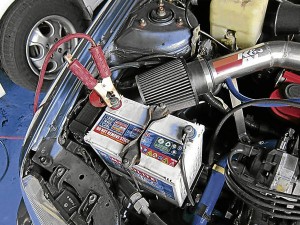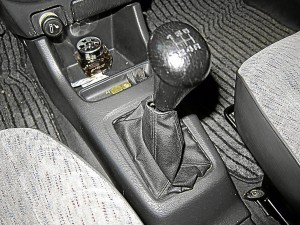How to apply ‘CPR’ to your troubled car

PARK the two vehicles together in such a way that you can connect the flat battery to the charged one using the jumper cables.
Who hasn’t experienced a car breakdown on the road? Veteran drivers know that, sooner or later, a man-made piece of machinery with thousands of moving parts will break down and stall. The only question is where that will happen.
Lest you feel smug that your brand spanking new car will not do that to you, well, think again. Just because it’s new doesn’t mean that all systems are clear. If manufacturers guaranteed that that their new cars wouldn’t experience problems, they wouldn’t have provided you with a toolbox, or a warranty, or a 24-hour standby towing service.
What every car owner should think about is this: Do I know what to do when my car suddenly conks out, or won’t start?
After 18 years of driving, and owning three second-hand manual transmission cars, yours truly has gotten her fair share of vehicle stalls and stutters, anywhere from the busy North and South Luzon Expressways, to the isolated country road to Baler in Aurora and Sagada, Mountain Province, for reasons as dumb as running out of fuel, to busted clutches, tire blowouts and conked-out batteries.
And I am so not looking forward to the next road misadventure. But being a “career” driver, I know I will encounter more of these.
However, after nearly two decades of literally hands-on experience, I’m also wise enough to anticipate what the likely breakdowns would be, and how to go about remedying them just enough so I can get moving again and bring the vehicles to the proper servicing and repair shops.
Here’s what you can do by yourself when your car suddenly gives up on you:
Seek out solutions on the dash first. According to Dan and Judy Ramsey, authors of “Teach Yourself Visually: Car Care Maintenance,” modern cars have numerous interlocks or steps that all require a signal that everything is working correctly before an engine can start. As an initial measure, try removing the key and reinsert it. The ignition switch may not have made full connections.
Check under the hood to inspect the battery. Make sure that the cables are firmly connected and that there is no corrosion, inspect the alternator to make sure that the wires are firmly connected. Make sure that the drive belt is not too loose.
The tell-tale sign that the problem may lie in the battery is that all your car’s electrical functions—lights, headlights, dashboard indicators—aren’t lighting up. In fact, a faulty, discharged or worn-out battery is one of the most common automotive malfunctions. If you’re in this situation, it’s time to apply “CAR-dio pulmonary rescuscitation,” or recharging the stricken battery manually.
Auto expert Deanna Sclar, author of “Auto Repair for Dummies,” advises motorists to read up the car’s manual first. If it indicates that the battery can be jumpstarted without harming the onboard computer, then they don’t need to call the towing service. They can whip out their jumper cables, flag down a good samaritan motorist (possibly, in this case, the friendly neighborhood taxicab), and attach the cables from the discharged battery to the running battery in seconds.
So, how does one do the “series,” as Pinoys would prefer to call this procedure?
1.) Park the two vehicles together in such a way that you can connect the flat battery to the charged one using the jumper cables. Jumper cables can be bought at car care shops. Note: “Make sure the two vehicles are not touching each other,” says the Ramseys. Steve Rendle, author of “The Car Book” warns: “Be wary when jump starting cars with engine management systems—careless jump starting, particularly if the leads are allowed to spark, can cause damage to the car’s electronic components.” He added that some cars, such as certain BMWs, are fitted with special connectors to allow jump starting, and on these cars the jump leads should only be connected to the special terminals provided. Read your car’s handbook carefully for special recommendations in these situations.
2.) Put both cars in “Park” (for automatic transmission) or Neutral (for manual transmissions) with ignition switches off and parking brakes on.
3.) Connect the cables in proper order. The positive cable has the red clips at either end, while the negative cable has black clips. Sclar stressed that it is important that you attach them in the proper order: a) Attach one of the red clips to the positive terminal of the dead battery (it should have a “POS” or “+” sign on it, or it is bigger than the negative terminal); b) Attach the other red clip to the positive terminal of the other motorist’s car; c) Attach one of the black clips to the negative terminal of the other motorist’s battery; then d) connect the other end of the black jump lead to a bolt or metal bracket well away from the battery, perhaps “on the engine block of the vehicle to be started,” suggests Rendle. Sclar would prefer “an unpainted metal surface on the car that isn’t near the battery, like the metal struts that holds the hood open.” The Ramseys, for their part, advise: “Attach the other end of the negative cable to an engine ground on the disabled vehicle’s engine.”
4.) Turn the ignition switch and start the vehicle. If it still won’t start, check that the cables are properly connected, and have the other vehicle run the engine for five minutes. Then try to start the car again. If it still won’t start, Sclar says, “Your battery may be beyond help.” By this time it would be best to opt for a car battery replacement. Some car battery manufacturers offer an on-the-spot delivery and repair service.
5.) If the jump works and your car starts, don’t shut off your engine immediately. Drive around for at least 15 minutes to recharge your battery.
Probably one of the most important yet overlooked part under the hood is the car battery. It would be worth following these preventive maintenance tips:
Check the battery terminals regularly, make sure that they’re secure and keep them free from corrosion. Rendle reveals that some car accessory shops sell battery terminal protector spray. Otherwise, you can just use petroleum jelly or grease. Keep the top of the battery clean and dry, however.
If your car makes lots of short journeys (home to office, and vice versa), it would be good to take your car on a long drive once in a while to help the alternator charge the battery.
Make sure that all the electrical equipment (lights, heater, blower, heated rear window, etc) is turned off before you start the engine.
Check the alternator drivebelt once in a while. At the first sign of trouble, such as difficulty starting, dim headlights, or if the charging warning light comes on, have the battery and your alternator tested.

















